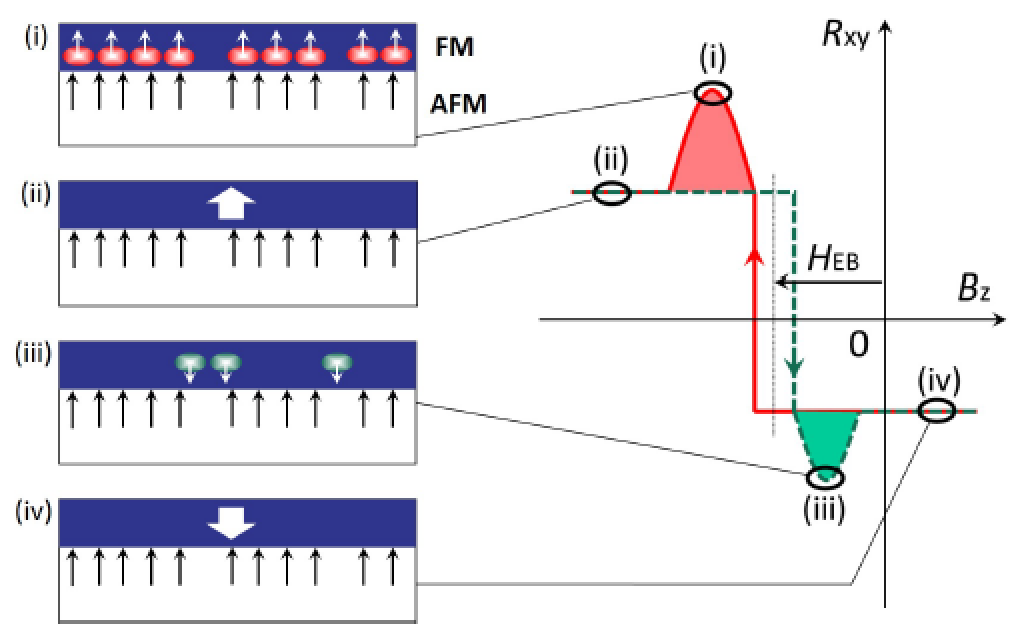Nature Communications reports Prof Qing Lin He et al.’s study on exchange biasing the topological charge using antiferromagnetism
2018-10-31
Spin-polarized carriers adiabatically moving through certain real-space topological spin textures can obtain a Berry’s phase as though they were in an applied magnetic field, resulting in a transverse carrier transport. Induced by this transverse transport, an extra Hall voltage can be observed, which is proportional to neither the applied external field nor the total magnetization. This spin-texture-induced extra Hall component is usually referred to as the “topological” or “geometric” Hall effect (GHE), which is a real-space counterpart of the k-space Berry phase in an intrinsic anomalous Hall effect (AHE). GHE is typically observed near magnetic reversal, within a window of the applied magnetic field and the temperature. Since the discovery of magnetic skyrmions in B20 compounds and heavy-metal multilayers, GHE has been considered as an experimental signature of topological spin textures (such as skyrmions) and, along with other real-space detection methods, it enables mapping of the magnetic topological phase diagram.
Recently, Prof Qing Lin He in ICQM – Peking University reported an experimental observation of the GHE modulated by uncompensated pinned spins in the antiferromagnetic (AFM) layer at the interface between an intrinsic TI thin film of (Bi,Sb)2Te3 and an AFM layer of MnTe. This suggests that a topologically nontrivial chiral spin texture is induced in the TI through interactions with the spin-polarized Mn planes of the MnTe. We find that the magnetic topological charge can be manipulated by a ‘seeding effect’ of pinned spins in the AFM layer. Systematic experimental results of the carrier magneto-transport, neutron scattering, and magnetic X-ray absorption spectroscopy support that the interfacial FM layer is induced in the TI through proximity interactions with the AFM layer.
Experimentally, it has been shown that special domain nucleation patterns can be induced by the spins in an adjacent AFM layer due to interfacial exchange coupling. In the following, it will be shown that this exchange coupling can result in a ‘seeding effect’ for the spin-texture topology. The microscopic picture is schematically shown by the four scenarios illustrated in the figure. After positive field cool (FC), some pinned spins can be frozen in the AFM layer along the FC direction (black arrows) due to thermoremanence. When the applied field sweeps to (i), positive topological charges [red circles with up central spins in (i)] are created through interactions with the pinned spins. After the saturation along a negative field (ii), these positive topological charges are annihilated. When the field scans to (iii), negative topological charges are prohibited by the pinning spins and therefore are more likely to nucleate outside the spin-pinned regions, but with a lower density [green circles with down central spins in (iii)]. These negative charges again vanish after magnetic saturation (iv). A similar modulation of topological charge occurs after a negative FC.
The above work was published on Nature Communications on July 17, 2018. The link to this paper is: https://www.nature.com/articles/s41467-018-05166-9.
This work was carried out by Prof Qing Lin He in ICQM, the group led by Prof Kang L Wang in UCLA, Dr. Alexander J. Grutter and Dr. Brian J. Kirby in National Institute of Standards and Technology (NIST), Dr. Padraic Shafer and Dr. Elke Arenholz in Advanced Light Source (ALS), the group led by Prof Xiaodong Han in Beijing University of Technology, and the group led by Prof Roger K. Lake in UC-Riverside. Prof Qing Lin He, Dr. Gen Yin, and Dr. Alexander J. Grutter are the first authors of the paper, while Prof Qing Lin He and Prof Kang L. Wang are the corresponding authors. This work is supported in part by the National Key R&D Program of China (Grant No. 2018YFA0305601).
Figure: A schematic demonstration of the exchange-biased topological charges. The anchoring spins in the AFM layer assist the nucleation of positive topological charges (red circles) while prohibit the negative ones (green circles).
